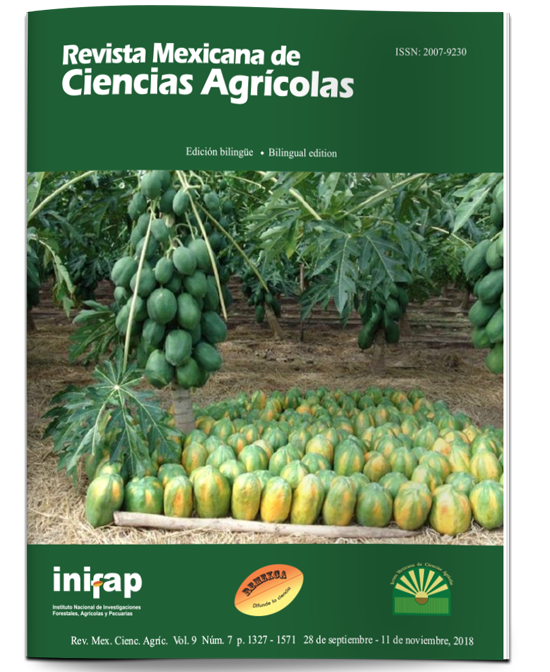Agronomic components and diversity in the pattern of fatty acids in advanced coriander lines
DOI:
https://doi.org/10.29312/remexca.v9i7.1674Keywords:
coriander, fatty acids, fresh biomass, genetic improvement, oilAbstract
Cilantro in Mexico is consumed fresh and the cultivated varieties are of foreign origin, and there are no reports of germplasm with high oil content that can be used in the industry. The objective was to evaluate phenotypically, morphologically and biochemically seven advanced coriander lines with desirable agronomic characteristics for production of fresh biomass and oil. Under a design in complete blocks at random the lines L9-CB, L13-CB, L17-CB, L21-CB, L25-CB, 29-CB and INIFAP-17 were sown. The agronomic management was carried out according to Gonzalez et al. (2017). The phenotypic, morphological and biochemical characters in plant and seed were determined. The best material for fresh production was the INIFAP-17 line for its greater number of basal leaves (31), fresh biomass (221 g) and long vegetative period, while for seed production the best lines were L9-CB (1.12 g pta-1) and L13-CB (1.16 g pta-1) are an option. The oil content of the advanced lines analyzed (6.21 to 11.23%) was higher than that reported in the literature (3-5%). Petroselinic acid was the majority with a concentration between 68.95 and 73.51 g 100 g-1 of oil, followed by linoleic acid (14.2 - 18.55 g 100 g-1 of oil). From a nutraceutical point of view, coriander oil presented an oleic/linoleic (O/L) ratio of less than 1. It is of interest to identify germplasm with a higher content of linoleic acid because the O/L ratio greater than 1 helps to prevent certain diseases.
Downloads
Downloads
Published
How to Cite
Issue
Section
License
The authors who publish in Revista Mexicana de Ciencias Agrícolas accept the following conditions:
In accordance with copyright laws, Revista Mexicana de Ciencias Agrícolas recognizes and respects the authors’ moral right and ownership of property rights which will be transferred to the journal for dissemination in open access. Invariably, all the authors have to sign a letter of transfer of property rights and of originality of the article to Instituto Nacional de Investigaciones Forestales, Agrícolas y Pecuarias (INIFAP) [National Institute of Forestry, Agricultural and Livestock Research]. The author(s) must pay a fee for the reception of articles before proceeding to editorial review.
All the texts published by Revista Mexicana de Ciencias Agrícolas —with no exception— are distributed under a Creative Commons License Attribution-NonCommercial 4.0 International (CC BY-NC 4.0), which allows third parties to use the publication as long as the work’s authorship and its first publication in this journal are mentioned.
The author(s) can enter into independent and additional contractual agreements for the nonexclusive distribution of the version of the article published in Revista Mexicana de Ciencias Agrícolas (for example include it into an institutional repository or publish it in a book) as long as it is clearly and explicitly indicated that the work was published for the first time in Revista Mexicana de Ciencias Agrícolas.
For all the above, the authors shall send the Letter-transfer of Property Rights for the first publication duly filled in and signed by the author(s). This form must be sent as a PDF file to: revista_atm@yahoo.com.mx; cienciasagricola@inifap.gob.mx; remexca2017@gmail.
This work is licensed under a Creative Commons Attribution-Noncommercial 4.0 International license.



